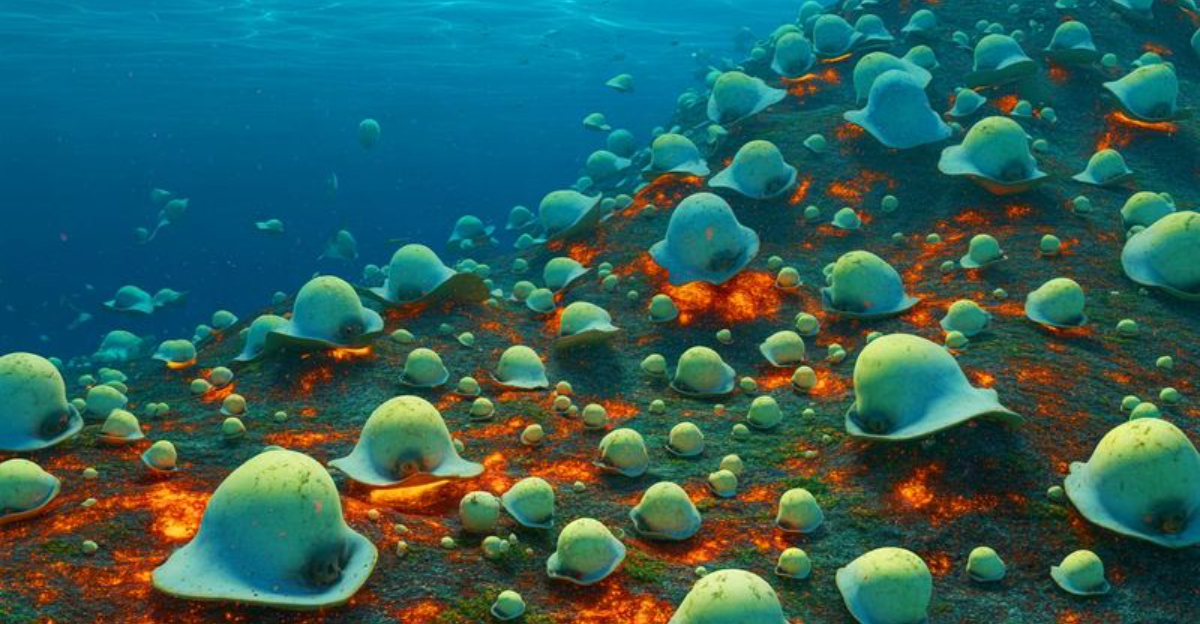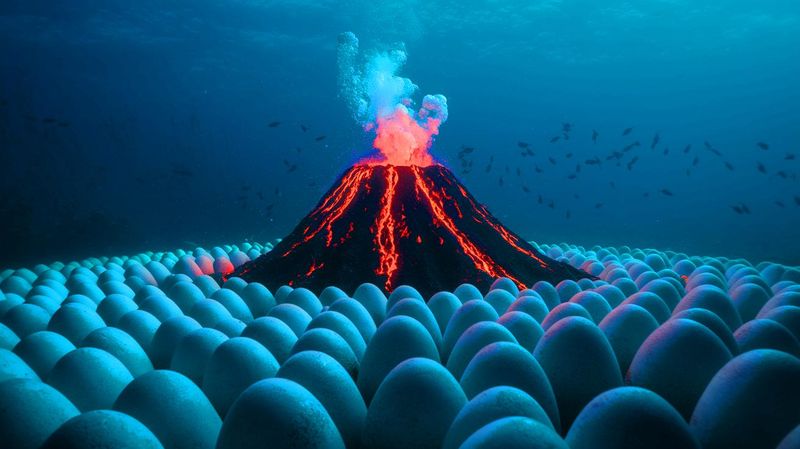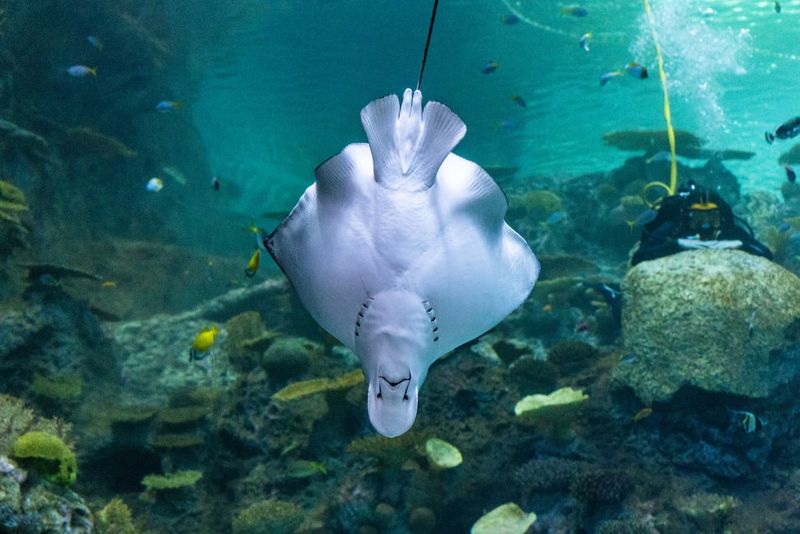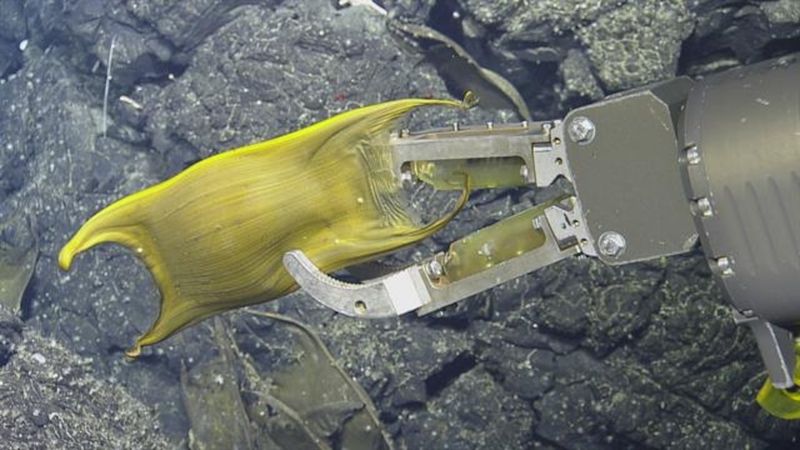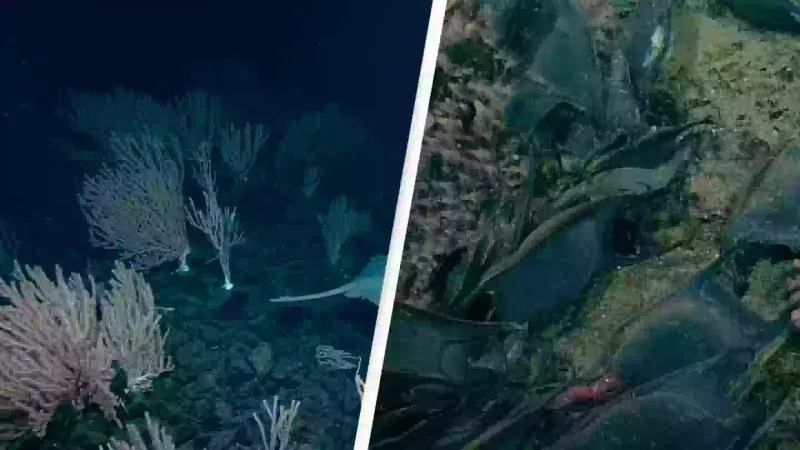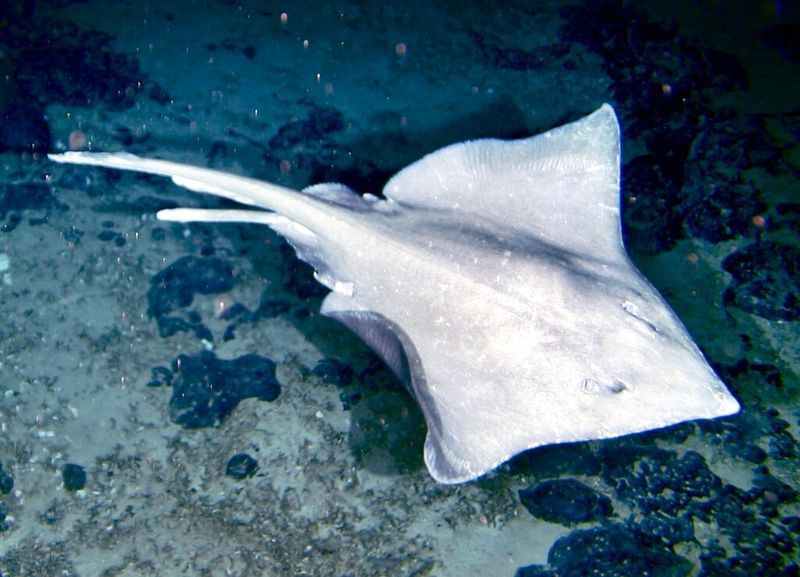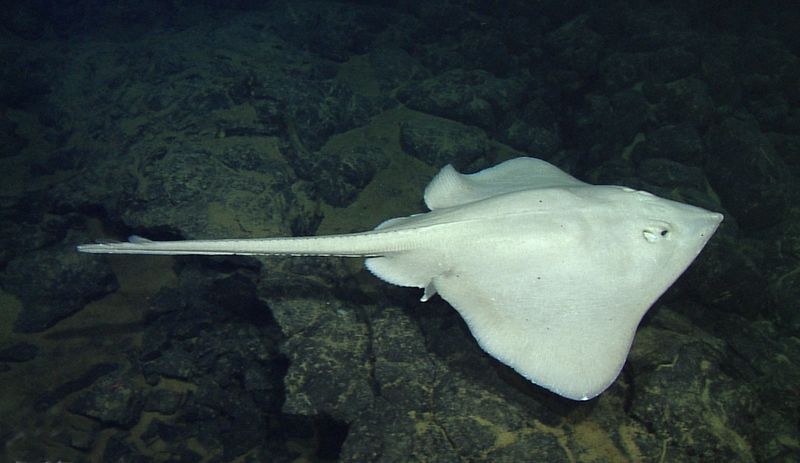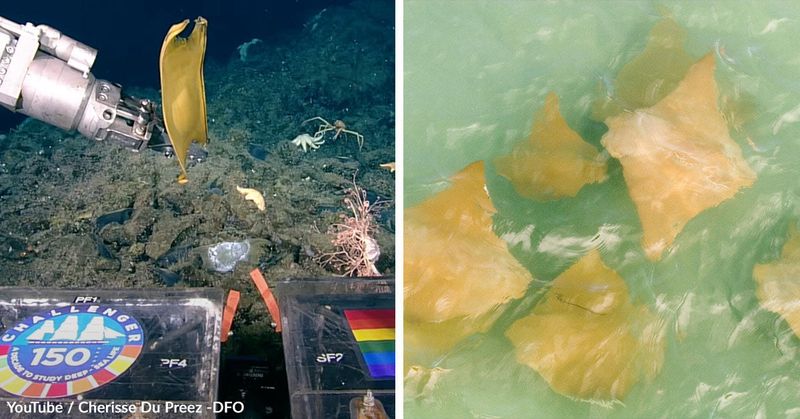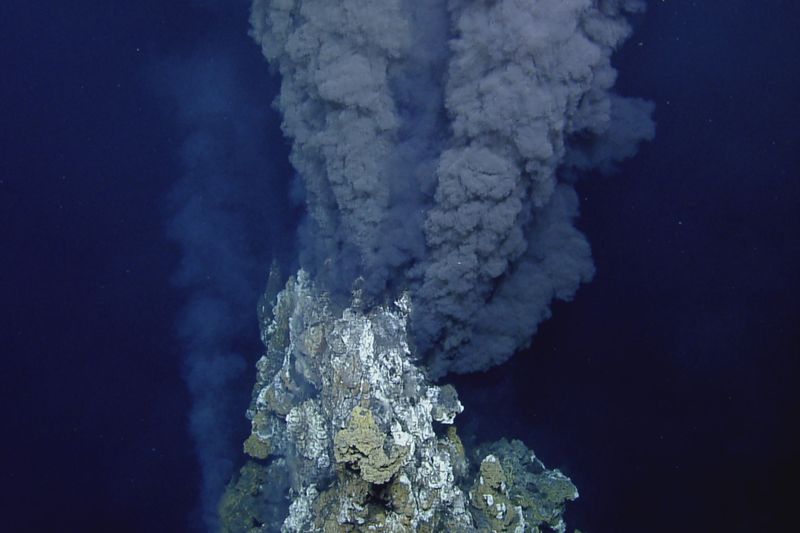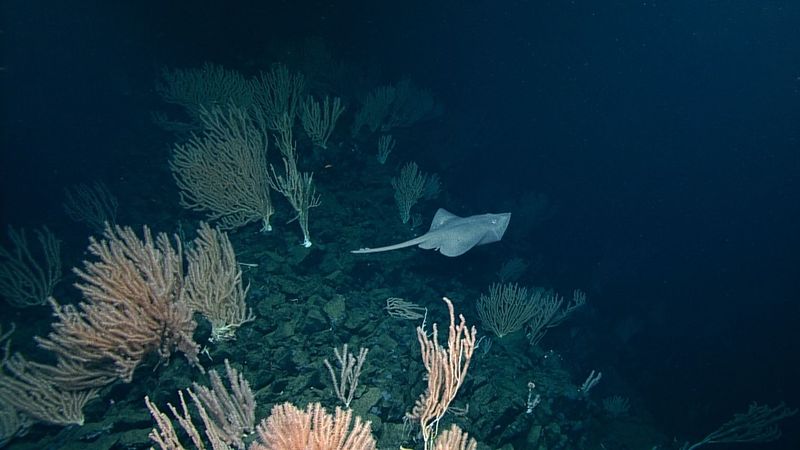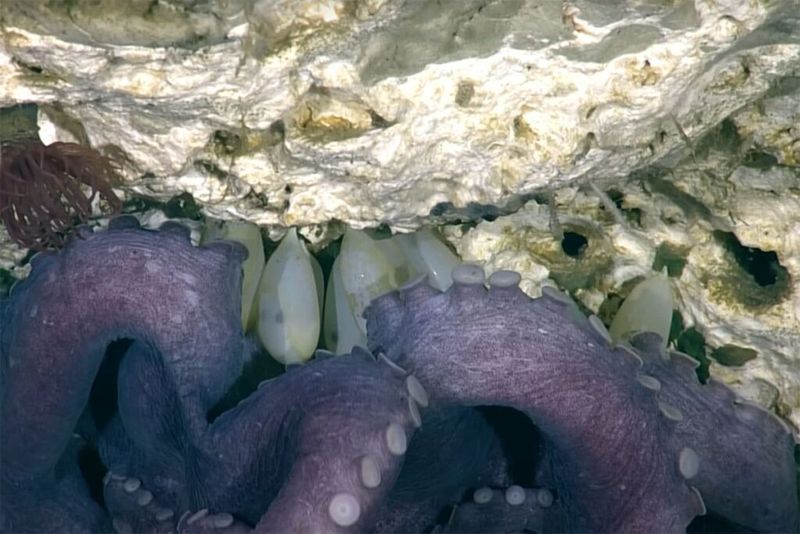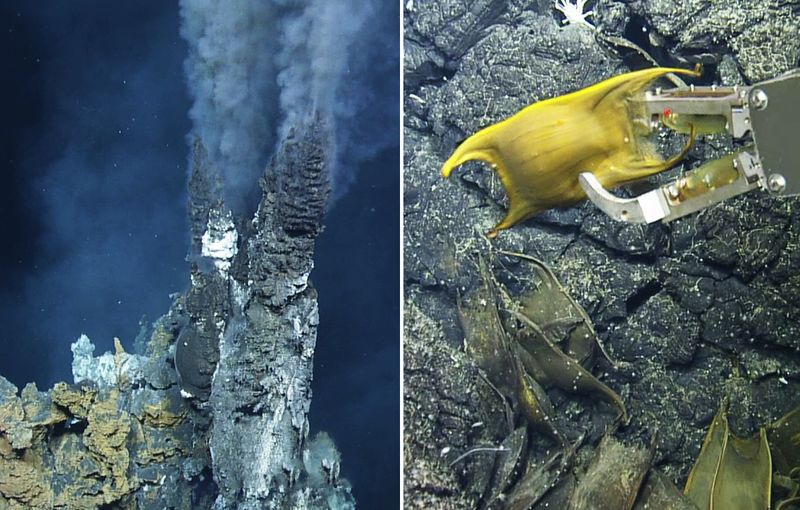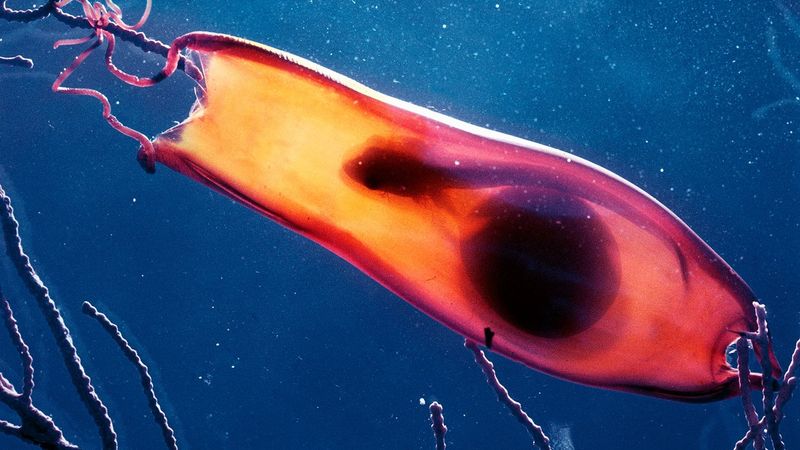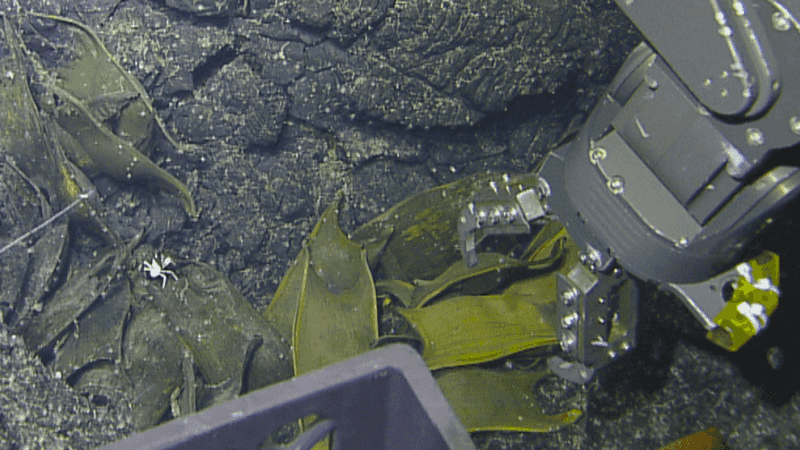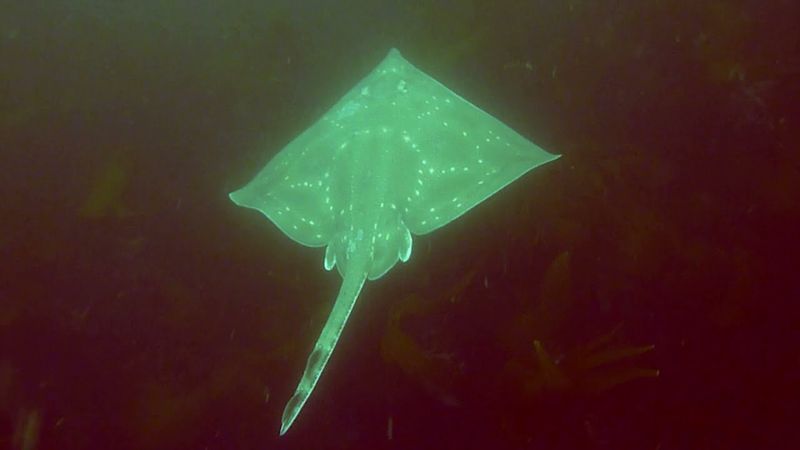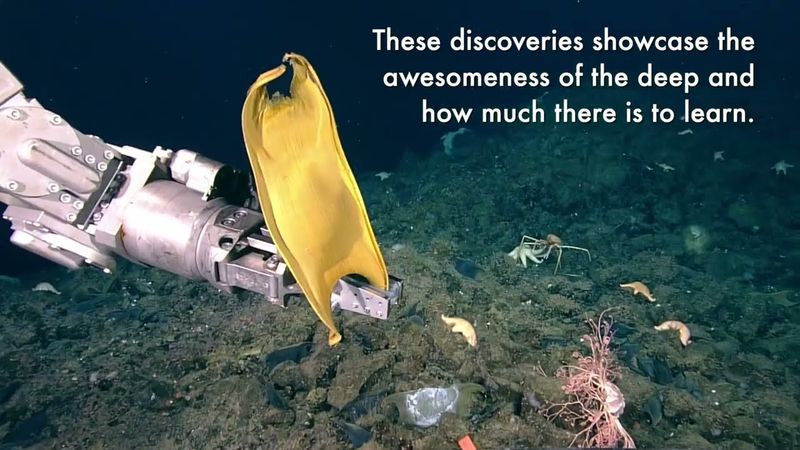Scientists recently made an incredible discovery near a Canadian underwater volcano – approximately 2.6 million golden eggs belonging to the Pacific white skate. This remarkable find has changed what we know about how sea creatures live in extreme environments. The eggs were found nestled in the warm waters around the volcano, creating a natural nursery that helps the baby skates develop faster than they would in the cold deep ocean.
1. Unexpected Deep-Sea Nursery
Marine biologists were stunned when they stumbled upon what appeared to be a golden carpet on the seafloor. What they found was actually millions of Pacific white skate eggs clustered around warm volcanic vents. The eggs utilize this natural heating system to speed up development in the otherwise frigid deep ocean.
This remarkable adaptation shows how deep-sea creatures find ingenious ways to survive. The volcano’s heat creates a perfect incubation environment, turning what would normally be a harsh setting into a thriving nursery ground for these relatives of sharks and rays.
2. Golden Giants of the Deep
These aren’t your average eggs! Each Pacific white skate egg case measures a whopping 1.5 feet across, making them some of the largest egg cases in the ocean. Their distinctive golden-yellow color stands out dramatically against the dark ocean floor.
Scientists compare them to dinner plates in size, creating a spectacular visual display when millions are gathered together. The tough, leathery casing protects the developing embryo for years until it’s ready to hatch.
The massive size likely provides extra protection and resources for the growing skate pups in their extreme environment.
3. Volcanic Speedup of Baby Skates
Talk about a long pregnancy! Without the volcano’s heat, these eggs would take a staggering 10 years to hatch in the cold deep sea. The volcanic warmth creates a natural incubator that significantly accelerates embryonic development.
This temperature boost might cut years off the hatching time. Scientists are still studying exactly how much faster the eggs develop in this unique thermal environment.
For a species living in such extreme conditions, this warming strategy gives the next generation a crucial head start in life, potentially increasing survival rates dramatically.
4. World’s First Egg-Laying Footage
Cameras captured something never before seen – a Pacific white skate in the act of laying her eggs near the volcano! This groundbreaking footage shows the mother carefully positioning her precious cargo in the warm water currents.
The video reveals how the female uses her body to anchor the egg case to the seafloor, ensuring it stays in the optimal temperature zone. Scientists were amazed to witness this behavior that had only been theorized until now.
This rare glimpse into deep-sea reproduction provides crucial information about breeding habits that were previously impossible to observe.
5. Volcano Thought Dead Teems with Life
Scientists got the shock of their careers when they discovered the seamount was actually an active volcano! For years, this underwater mountain was classified as extinct, but the discovery of thermal activity and the skate nursery proved otherwise.
The volcano creates a perfect microclimate for these eggs through gentle, consistent heat release. Unlike violent eruptions we see on land, this underwater volcano provides a stable environment.
This revelation has forced researchers to reconsider how they classify underwater volcanoes and highlights how much we still have to learn about our ocean depths.
6. Mile-Deep Coral Garden Paradise
Nearly a mile beneath the waves, the summit of this underwater volcano hosts an unexpected paradise. Vibrant coral gardens thrive here, creating a diverse ecosystem that supports countless species including the Pacific white skate.
Cold-water corals in brilliant hues create a stark contrast to the golden eggs scattered throughout. This biological hotspot demonstrates how life clusters around energy sources in the otherwise sparse deep ocean.
The corals provide crucial protection for the eggs, hiding them from potential predators while also creating complex currents that help circulate oxygen-rich water around the developing embryos.
7. Second Known Skate Nursery Ever Found
Lightning has struck twice in the deep sea! This massive nursery marks only the second known Pacific white skate breeding ground ever discovered. The first, found near the Galápagos Islands, was tiny in comparison.
While the Galápagos site contained just hundreds of eggs, this Canadian volcano houses millions. The sheer scale difference raises fascinating questions about skate population dynamics and breeding preferences.
Finding this second nursery allows scientists to compare the two sites and better understand what makes an ideal breeding location for these mysterious creatures.
8. Masters of Extreme Environments
Pacific white skates are truly champions of the deep! These remarkable creatures thrive at crushing depths between 2,600 and 9,500 feet where pressure would flatten most organisms. Their bodies have evolved specialized adaptations to handle these extreme conditions.
Special cellular structures prevent them from being crushed, while unique blood chemistry allows them to extract oxygen from the sparse deep waters. Their flattened bodies help them conserve energy in this food-scarce environment.
Few creatures can survive in such harsh conditions, making the Pacific white skate one of the ocean’s most resilient specialists.
9. Unprotected Treasure Under Threat
Despite its biological significance, this underwater nursery currently lacks formal protection. Deep-sea trawling and other fishing activities pose serious threats to this vulnerable ecosystem and its precious golden cargo.
Bottom-contact fishing gear could devastate the nursery in a single pass. The slow reproductive rate of Pacific white skates makes them especially vulnerable to population decline if breeding grounds are damaged.
Conservation groups are urgently calling for this area to be designated as a marine protected zone before irreversible damage occurs. The discovery has sparked important discussions about safeguarding deep-sea habitats.
10. Nature’s Perfect Incubator System
Mother Nature engineered a perfect incubation system at this volcanic site! The geothermal heat creates ideal temperature gradients for egg development, with warmer zones near vents and cooler areas farther away.
This natural temperature variation allows mother skates to place their eggs precisely where conditions are optimal. The mineral-rich waters surrounding the volcano also provide essential nutrients that strengthen the developing embryos.
Researchers are amazed by how the skates have adapted to utilize this volcanic feature, essentially turning a harsh environment into a sophisticated nursery that rivals human-designed incubation systems.
11. Vast Unknown Depths Still Surprise Us
We’ve mapped more of Mars than our own deep oceans! This discovery highlights how much remains unknown in Earth’s final frontier. Scientists estimate we’ve explored less than 20% of our oceans, with new species and phenomena discovered regularly.
The skate nursery was found during a routine survey that wasn’t specifically looking for marine life. Many researchers believe countless similar discoveries await in unexplored regions of our oceans.
With each new expedition, we’re reminded that the deep sea holds secrets that challenge our understanding of life’s possibilities.
12. Smart Reproductive Strategy
Pacific white skates are ocean strategists! By selecting warm volcanic areas for egg-laying, these clever creatures boost their offspring’s chances of survival dramatically. The warmth speeds development, reducing the vulnerable egg stage when predation risk is highest.
Additionally, the mineral-rich waters provide nutrients that strengthen egg cases and embryos. The remote location also keeps the eggs safe from many shallow-water predators that can’t survive at such depths.
This reproductive strategy represents millions of years of evolutionary fine-tuning, resulting in an ingenious solution to the challenges of deep-sea reproduction.
13. Life Finds a Way in Harshest Places
The discovery of thriving life near an active volcano shatters previous assumptions about habitable environments! Scientists once believed these extreme conditions were too harsh for complex life forms. The skate nursery proves otherwise.
High pressure, minimal light, toxic minerals, and fluctuating temperatures create challenges that would kill most organisms. Yet here, life not only survives but flourishes.
This remarkable resilience echoes findings in other extreme environments like deep-sea vents and Antarctic ice lakes, reinforcing the extraordinary adaptability of life on Earth and expanding our search parameters for life on other planets.
14. Scientists From Different Fields Unite
The golden egg discovery has sparked unprecedented collaboration across scientific disciplines! Marine biologists, volcanologists, oceanographers, and climate scientists are working together to understand this unique ecosystem.
Each field brings specialized knowledge: biologists study the skates, volcanologists analyze the thermal activity, and oceanographers examine how currents distribute nutrients and heat. This cross-disciplinary approach creates a more complete picture than any single field could provide alone.
The project has become a model for how complex environmental discoveries benefit from diverse scientific perspectives working in harmony.
15. Golden Eggs Captivate Public Imagination
The story of golden eggs hidden near an underwater volcano has fired up public imagination worldwide! The fairy-tale quality of this discovery – golden treasures hidden in an underwater mountain – resonates with people of all ages.
Social media has exploded with artistic interpretations and memes about the eggs. Educational institutions report increased interest in marine biology programs since the discovery went viral.
This public fascination has been invaluable for raising awareness about ocean conservation and the importance of deep-sea research funding, turning scientific discovery into cultural phenomenon.
16. Cutting-Edge Tech Made Discovery Possible
Without recent technological breakthroughs, this golden nursery would remain hidden forever! Advanced remotely operated vehicles (ROVs) equipped with 4K cameras and specialized lighting systems captured the first-ever footage of the eggs and laying behavior.
Pressure-resistant materials allow these machines to operate at depths that would crush traditional equipment. Sophisticated sonar and mapping systems created detailed 3D models of the volcano and egg distribution patterns.
The same technology enabling space exploration is now revealing Earth’s final frontier, with each new generation of deep-sea tech expanding our understanding of these mysterious realms.
17. Growing Calls for Ocean Preservation
The golden egg discovery has become a powerful symbol in the fight for ocean protection! Conservation organizations are using this remarkable nursery to highlight the urgent need for expanded marine protected areas in international waters.
Currently, less than 3% of the high seas have meaningful protection from human activities like fishing and mining. The skate nursery demonstrates how undiscovered wonders could be destroyed before we even know they exist.
Politicians and policymakers previously dismissive of ocean conservation efforts have been moved by images of this extraordinary phenomenon, sparking renewed interest in international marine protection treaties.
18. Inspiration for Further Ocean Exploration
The golden egg discovery has ignited a wave of new deep-sea expeditions! Research institutions worldwide are launching missions to investigate other underwater volcanoes and seamounts that might harbor similar biological treasures.
Funding for deep-ocean exploration has increased dramatically as both governments and private organizations recognize the potential for groundbreaking discoveries. Young scientists cite the skate nursery as their inspiration for pursuing careers in marine biology and oceanography.
Each new expedition builds on knowledge gained from the original discovery, creating a snowball effect of underwater exploration and scientific advancement.
19. Classroom Sensation Sparks Young Scientists
The golden eggs have become superstars in science classrooms around the world! Teachers report unprecedented engagement when covering this discovery, with students captivated by the combination of extreme environments, mysterious creatures, and golden treasures.
Educational materials featuring the skate nursery have been developed for all age groups. Some schools have created model volcanoes with golden egg replicas as hands-on learning tools.
The discovery provides a perfect entry point to discuss ocean ecosystems, adaptation, and conservation with young learners, potentially inspiring the next generation of marine scientists and conservationists.
20. Nature’s Wonders Hidden in the Deep
The golden egg discovery reminds us that Earth’s most spectacular wonders often remain hidden from human eyes! While we marvel at mountains and canyons on land, equally impressive spectacles exist in the ocean depths.
The visual contrast of millions of golden eggs against the dark volcanic landscape creates a scene more fantastic than anything in science fiction. Yet this is just one of countless natural phenomena occurring daily in unexplored ocean regions.
As one scientist poetically noted, “The deep sea holds Earth’s greatest art gallery, with masterpieces we’re only beginning to glimpse.”
